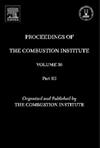Effect of temperature disturbance on end-gas autoignition and detonation development
IF 5.3
2区 工程技术
Q2 ENERGY & FUELS
引用次数: 0
Abstract
Knocking is one of the main constrains in improving the thermal efficiency of spark ignition engines. It is generally accepted that normal knock and super-knock are respectively caused by autoignition and detonation development in end-gas. In this study, the effect of temperature disturbance on end-gas autoignition and detonation development in a closed circular domain is examined through 2D simulations considering detailed chemistry. In simulations we find typical end-gas combustion modes including triple-detonation, double-detonation and double-tongue structures, which were also observed in previous rapid compression machine (RCM) experiments. It is shown that the detonation development in end-gas is very sensitive to the temperature disturbance, Δ. As Δ increases, the first autoignition in end-gas induced by temperature disturbance occurs earlier while the corresponding pressure wave is weaker, which subsequently results in different combustion modes in end-gas. Specifically, for small Δ, a supersonic autoignition is initiated and then it triggers a triple-detonation structure consisting of a radial detonation induced by shock-flame coupling and two circumferential detonations that are caused by the near-wall shock compression induced detonation (NWSCD) mechanism. For moderate Δ, the radial detonation is suppressed due to the earlier first autoignition and weaker pressure waves, and thereby the double-detonation structure consisting of two circumferential detonations appears. These two detonations are formed through near wall autoignition induced detonation (NWAID) mechanism. For relatively large Δ, there is no detonation development since the end-gas is quickly consumed by autoignition, which results in a double autoignition front structure, referred to as the double-tongue structure. In this study, the formation of complicated autoignition and detonation structures is interpreted. The results provide insight in understanding the development of normal knock and super-knock in spark ignition engines.温度干扰对末端气体自燃和爆燃发展的影响
爆震是提高火花点火发动机热效率的主要制约因素之一。一般认为,正常爆震和超级爆震分别是由尾气中的自燃和爆震发展引起的。在本研究中,我们通过二维模拟研究了温度扰动对封闭圆域中尾气自燃和爆燃发展的影响,并考虑了详细的化学成分。在模拟中,我们发现了典型的尾气燃烧模式,包括三重爆燃、双重爆燃和双舌结构,这些在之前的快速压缩机(RCM)实验中也有观察到。研究表明,尾气中的爆燃发展对温度扰动 Δ 非常敏感。随着 Δ 的增大,温度扰动引起的尾气中的第一次自燃会提前发生,而相应的压力波会减弱,从而导致尾气中出现不同的燃烧模式。具体来说,当Δ较小时,超音速自燃开始,然后引发三重爆燃结构,包括由冲击-火焰耦合诱发的径向爆燃和由近壁冲击压缩诱发爆燃(NWSCD)机制引起的两个周向爆燃。对于中等Δ,由于第一次自燃较早且压力波较弱,径向爆轰受到抑制,因此出现了由两个周向爆轰组成的双爆轰结构。这两个爆轰是通过近壁自燃诱发爆轰(NWAID)机制形成的。对于相对较大的Δ,由于末端气体很快被自燃消耗,因此没有爆轰发展,从而形成双自燃前沿结构,称为双舌结构。本研究解释了复杂自燃和起爆结构的形成。研究结果有助于理解火花点火发动机中正常爆震和超级爆震的发展。
本文章由计算机程序翻译,如有差异,请以英文原文为准。
求助全文
约1分钟内获得全文
求助全文
来源期刊

Proceedings of the Combustion Institute
工程技术-工程:化工
CiteScore
7.00
自引率
0.00%
发文量
420
审稿时长
3.0 months
期刊介绍:
The Proceedings of the Combustion Institute contains forefront contributions in fundamentals and applications of combustion science. For more than 50 years, the Combustion Institute has served as the peak international society for dissemination of scientific and technical research in the combustion field. In addition to author submissions, the Proceedings of the Combustion Institute includes the Institute''s prestigious invited strategic and topical reviews that represent indispensable resources for emergent research in the field. All papers are subjected to rigorous peer review.
Research papers and invited topical reviews; Reaction Kinetics; Soot, PAH, and other large molecules; Diagnostics; Laminar Flames; Turbulent Flames; Heterogeneous Combustion; Spray and Droplet Combustion; Detonations, Explosions & Supersonic Combustion; Fire Research; Stationary Combustion Systems; IC Engine and Gas Turbine Combustion; New Technology Concepts
The electronic version of Proceedings of the Combustion Institute contains supplemental material such as reaction mechanisms, illustrating movies, and other data.
文献相关原料
| 公司名称 | 产品信息 | 采购帮参考价格 |
|---|
 求助内容:
求助内容: 应助结果提醒方式:
应助结果提醒方式:


